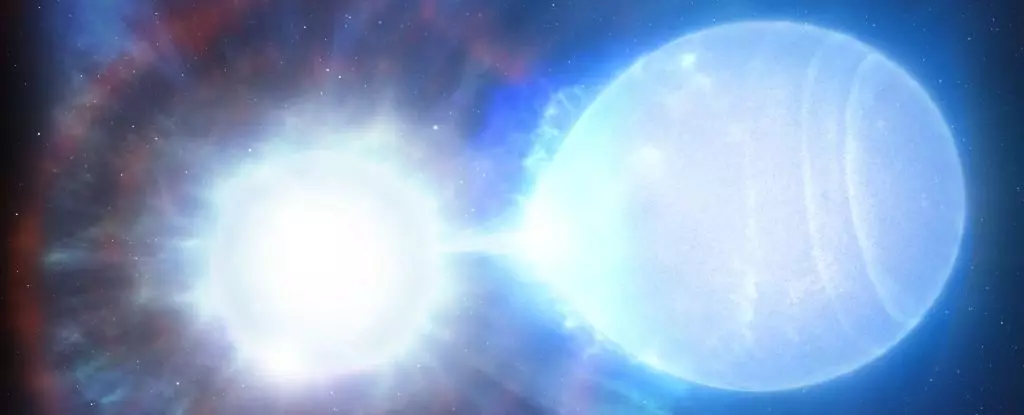In the grand ballet of the universe, every star eventually reaches its conclusion, extinguishing its blazing brilliance in an epic end. Among the multitude of celestial bodies dotted across the night sky, the fate of binary star systems is particularly intriguing. These systems, composed of two stars orbiting around each other, are not just partners in a cosmic waltz; they hold secrets to the very evolution of the universe itself. Recently, astronomers have shed light on a binary white dwarf system located approximately 150 light years away, which is poised for a spectacular demise in the distant future—around 23 billion years from now, that is. However, this impending dance is set to be interrupted not by a graceful exit but by the violent eruption of a Type Ia supernova, one of the universe’s most significant phenomena.
Illuminating Cosmic Truths with Type Ia Supernovae
Type Ia supernovae have become pivotal markers in the cosmic yardstick used to measure astronomical distances. Understanding their origins has significant implications for a broad array of astrophysical research, including the expansion rate of the universe. It was long theorized that many of these luminous explosions originate from white dwarf stars that coalesce in a binary system. This theory has often eluded verification—until now. The confirmation that two white dwarfs can exist side by side on the brink of catastrophic union offers a remarkable insight into their role in creating the powerful explosions of Type Ia supernovae.
Astrophysicist James Munday from Warwick University articulated the breakthrough well: “The companion being a second white dwarf is a natural explanation for a large fraction of Type Ias.” This clear link between binary white dwarfs and Type Ia supernovae has finally materialized from a sea of speculation, ushering in a new era in our understanding of these cosmic illuminations.
A Closer Look at Binary White Dwarfs
White dwarfs are intriguing remnants of stars that have exhausted their hydrogen fuel. When a star similar in mass to our Sun reaches the end of its life, it undergoes a series of transformations, culminating in the shedding of its outer layers while the core collapses into a compact, ultra-dense white dwarf. However, when two white dwarfs exist in close proximity, their fates become intertwined. As they orbit, one white dwarf can siphon material from its partner, eventually accumulating enough mass to breach the critical Chandrasekhar limit. This mass limit is not just a number; it represents a threshold that, once exceeded, leads to a supernova explosion—a release of energy and a dispersal of heavy elements into the cosmos.
In the case of the newly identified binary system WDJ181058.67+311940.94, we are privy to a unique cosmic narrative. At a combined mass of about 1.56 times our Sun, these two stars are positioned closer than ever observed in similar systems. Over time, their orbits will decay, drawing them nearer to an explosive end. “Slurp … boom!” encapsulates the endgame of their celestial partnership—a brilliant flash signaling the death knell not just for the stars, but a resounding affirmation for scientists as they seek to understand more about these brilliant explosions.
Implications for Cosmology and Beyond
This discovery has monumental implications for our understanding of stellar evolution and the mechanisms behind cosmic explosions. For far too long, hypotheses around Type Ia supernovae remained largely speculative, unanchored by empirical evidence. Munday’s team has flipped this narrative on its head, providing an example that could allow astronomers to identify similar systems in the universe.
The significance of this discovery is monumental. The cycle of creation and destruction in the universe, driven by these celestial explosions, is one of its most captivating features. Heavy elements produced in these stellar blasts are essential for the formation of planets and, by extension, life itself. By understanding these events better, we not only indulge our curiosity about cosmic phenomena but also delve deeper into the very foundations of our existence as creatures of a starry night.
The Future of Cosmic Exploration
With cutting-edge technologies capable of mining vast amounts of data from the cosmos, the potential to uncover more binary systems like WDJ181058.67+311940.94 is within reach. This technological advancement combined with this vital discovery indicates that we live in a particularly exciting time for astrophysics. More secrets may lie in the dark voids of space, waiting patiently for our understanding. As we unearth more such systems, we will enrich both our knowledge of the universe and the tapestry of time—one flickering star at a time.
In the vast theater of the cosmos, the curtain may be far from drawn; rather, it may just be the beginning of an awe-inspiring act. The dance of the binary stars reminds us that the magnificent narrative of the universe is ever-unfolding, revealing layers of complexity, beauty, and wonder beyond our imagination.

